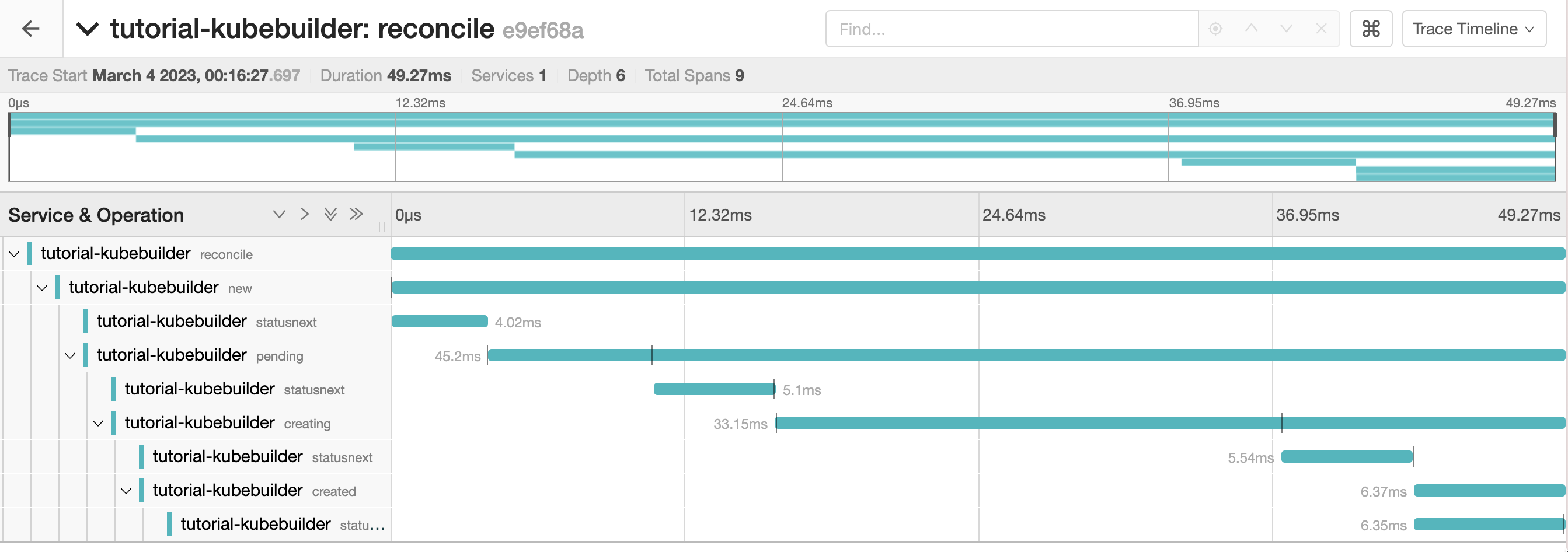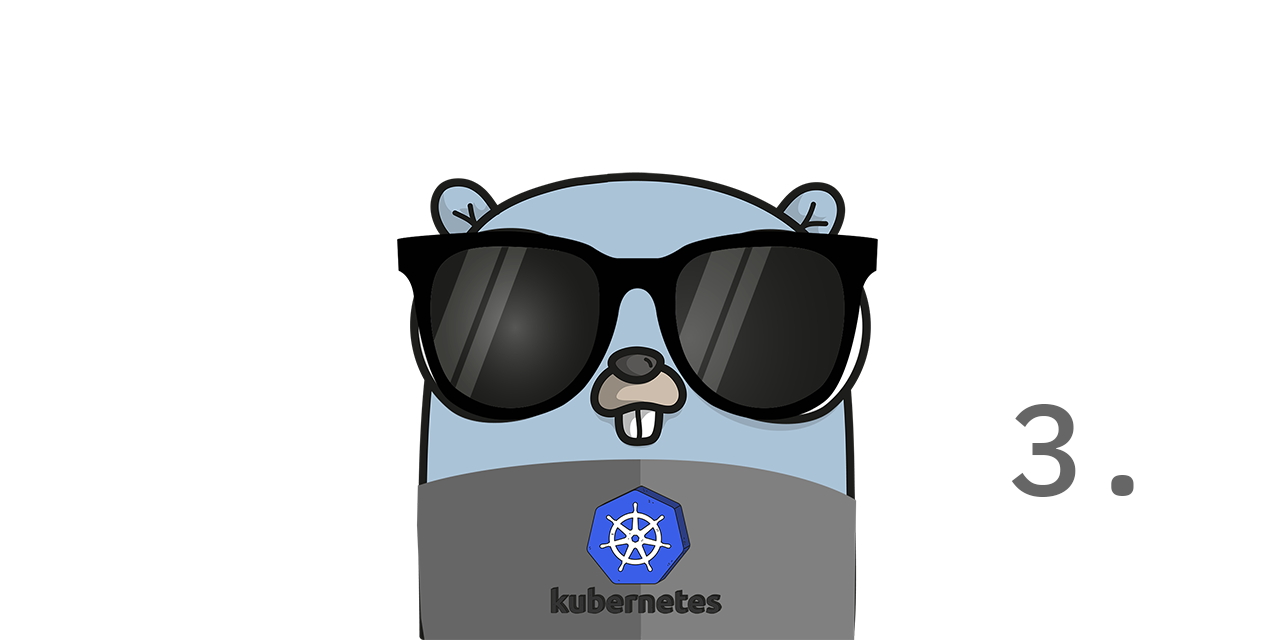Extending the Operator
Intro #
This article is a part of a tutorial series about creating a Kubernetes operator with Kubebuilder in Go. We are covering the following topics:
- Creating a development cluster
- Tracing, Logging, Kubernetes event recording
- Lifecycle of a Resource in Kubernetes, including Finalizers
- Triggering the reconciliation manually (based on a custom annotation)
- Search indexing
- Formatting the output of
kubectl get
The articles of the series are:
- Part 1 - Preparing a development cluster
- Part 2 - Creating an API and a Controller
- Part 3 - Extending the operator
- Source code: https://github.com/janosmiko/tutorial-kubebuilder
Extending the Operator #
The Reconciliation loop #
In the next step we are going to do the following:
- Prepare a context with deadline to make sure we don’t get stuck in the loop.
- Prepare the logger and the tracer.
- Move the Resource to terminating state if the Resource’s
DeletionTimestampis not zero - and restart the reconciliation. - Add a Finalizer to our Resource if it doesn’t contain one - and restart the reconciliation.
if !o.ObjectMeta.DeletionTimestamp.IsZero() &&
v1alpha1.DomainresolverStatusPhase(o.Status.Phase.Type) != v1alpha1.DomainresolverStatusPhaseTerminating {
span.AddEvent("DomainResolver is being deleted, setting it's status to terminating")
log.Info("DomainResolver is being deleted, setting it's status to terminating")
err := r.statusNext(
ctx,
o,
v1alpha1.DomainresolverStatusPhaseTerminating,
"DomainResolver terminating",
DomainresolverReasonTerminating,
false,
)
if err != nil {
span.RecordError(err)
return ctrl.Result{}, err
}
return ctrl.Result{Requeue: true}, nil
}
if !controllerutil.ContainsFinalizer(o, DomainresolverFinalizerName) {
span.AddEvent("Adding finalizer to the DomainResolver")
log.Info("Adding finalizer to the DomainResolver")
patch := client.MergeFrom(o.DeepCopy())
controllerutil.AddFinalizer(o, DomainresolverFinalizerName)
err = r.Client.Patch(ctx, o, patch)
if err != nil {
span.RecordError(err)
return ctrl.Result{}, err
}
return ctrl.Result{Requeue: true}, nil
}
switch v1alpha1.DomainresolverStatusPhase(o.Status.Phase.Type) {
case "":
return r.ReconcileNew(ctx, o)
case v1alpha1.DomainresolverStatusPhasePending:
return r.ReconcilePending(ctx, o)
case v1alpha1.DomainresolverStatusPhaseCreating:
return r.ReconcileCreating(ctx, o)
case v1alpha1.DomainresolverStatusPhaseCreated:
return r.ReconcileCreated(ctx, o)
case v1alpha1.DomainresolverStatusPhaseTerminating:
return r.ReconcileTerminating(ctx, o)
case v1alpha1.DomainresolverStatusPhaseDeleted:
return r.ReconcileDeleted(ctx, o)
case v1alpha1.DomainresolverStatusPhaseError:
return r.ReconcileError(ctx, o)
default:
return ctrl.Result{}, fmt.Errorf("unknown status: %s", o.Status.Phase.Type)
}
Additional functions #
We are going to create a few helper functions to make the code more readable. As they are quiet long, I’m not going to include them here. I’ll just add a link to the source code.
- statusNext: this function is going to update the status of the Resource and set the next phase.
- CreateSpecHash: this function is going to create an SHA-256 hash from the Spec of the Resource. It is useful to track if the Spec has changed.
Add a manual trigger #
We can also add a trigger to make it easy to restart the reconciliation process from the beginning.
To do so, define a checkTrigger function. This is going to look for an annotation that have to contain a date. If it’s newer than the last transition time, it’s going to return true.
func (r *DomainresolverReconciler) checkTrigger(o *v1alpha1.Domainresolver) bool {
reset := o.GetAnnotations()["tutorial.janosmiko.com/reset"]
// Parse date from trigger annotation if it's formatted: `date -Iseconds -r 1533415339`
layout := time.RFC3339
t, err := time.Parse(layout, reset)
if err != nil {
return false
}
// Check if trigger is newer than the last transition time
if t.After(o.Status.Phase.LastTransitionTime.Time) {
return true
}
return false
}
Now inject that function to the main reconciliation loop.
if r.checkTrigger(o) {
return r.ReconcileReset(ctx, o)
}
Trigger the trigger
kubectl annotate -n default domainresolver.tutorial.janosmiko.com domainresolver-sample --overwrite \ ─╯
tutorial.janosmiko.com/reset="$(date -Iseconds)"
Create an example indexer #
First of all, to enable access to additional resources, you’ll have to add the following annotation to the beginning of the internal/controller/domainresolver_controller.go file:
//+kubebuilder:rbac:groups="*",resources=pods,verbs=get;list
Next, add an indexer to the SetupWithManager function.
The following example is going to index the Pods by the first container’s names inside them.
Using this indexer we will be able to search for all Pods whose first container’s name is “x”.
if err := mgr.GetFieldIndexer().IndexField(
context.Background(),
&apiv1.Pod{},
".customIndexer.pods.byFirstContainerName",
func(rawObj client.Object) []string {
pod, ok := rawObj.(*apiv1.Pod)
if !ok {
return nil
}
return []string{pod.Spec.Containers[0].Name}
},
); err != nil {
return err
}
Rebuild and Restart #
$ make generate && make manifests && make install
$ make docker-build IMG=controller:latest
$ kind load docker-image controller:latest -n test
$ make deploy IMG=controller:latest
$ kubectl rollout restart deployment -n tutorial-kubebuilder-system tutorial-kubebuilder-controller-manager
Define and Apply our Custom Resource #
$ cat << EOF >config/samples/_v1alpha1_domainresolver.yaml
apiVersion: tutorial.janosmiko.com/v1alpha1
kind: Domainresolver
metadata:
labels:
app.kubernetes.io/name: domainresolver
app.kubernetes.io/instance: domainresolver-sample
app.kubernetes.io/part-of: tutorial-kubebuilder
app.kubernetes.io/managed-by: kustomize
app.kubernetes.io/created-by: tutorial-kubebuilder
name: domainresolver-sample
spec:
id: test
domain: janosmiko.com
EOF
$ kubectl apply -f config/samples/_v1alpha1_domainresolver.yaml
The results #
We can check the custom resource’s status by running
kubectl get domainresolver.tutorial.janosmiko.com domainresolver-sample -o yaml
...
status:
conditions:
- lastTransitionTime: '2023-03-03T22:38:00Z'
message: DomainResolver created
reason: DomainresolverCreated
status: 'True'
type: Created
- lastTransitionTime: '2023-03-03T22:38:00Z'
message: DomainResolver creating
reason: DomainresolverCreating
status: 'False'
type: Creating
- lastTransitionTime: '2023-03-03T22:38:00Z'
message: Preparing DomainResolver
reason: DomainresolverNew
status: 'False'
type: Pending
ipAddress: 185.199.109.153
phase:
lastTransitionTime: '2023-03-03T22:38:00Z'
message: DomainResolver created
reason: DomainresolverCreated
status: 'True'
type: Created
ready: true
specHash: b442cc366de2547e17f97cf4dd72f9f90340639570f583bc801f2d570df820a1
spec:
domain: janosmiko.com
id: test
Formatting #
If we print the results in regular format, we will not see anything from the spec or the status.
$ kubectl get domainresolver.tutorial.janosmiko.com domainresolver-sample -o wide
NAME AGE
domainresolver-sample 5m24s
But it is possible to add custom columns to make the kubectl get output prettier.
Add the following lines to the api/v1alpha1/domainresolver_types.go to get better results.
//+kubebuilder:printcolumn:name="Age",type="date",JSONPath=".metadata.creationTimestamp",description="The age of the domainresolver"
//+kubebuilder:printcolumn:name="Domain",type="string",JSONPath=".spec.domain",description="The domain name assigned to the domainresolver"
//+kubebuilder:printcolumn:name="IP Address",type="string",JSONPath=".status.ipAddress",description="The IP address assigned to the domainresolver"
//+kubebuilder:printcolumn:name="Image ID",type="string",JSONPath=".status.controllerImageID",description="The Image ID of the kube-rbac-proxy"
Now rebuild and check the results again.
$ kubectl get domainresolver.tutorial.janosmiko.com domainresolver-sample -o wide
NAME AGE DOMAIN IP ADDRESS IMAGE ID
domainresolver-sample 12s janosmiko.com 185.199.109.153 blabla
Tracing #
We can also see the traces of the reconciliation process in Jaeger.


